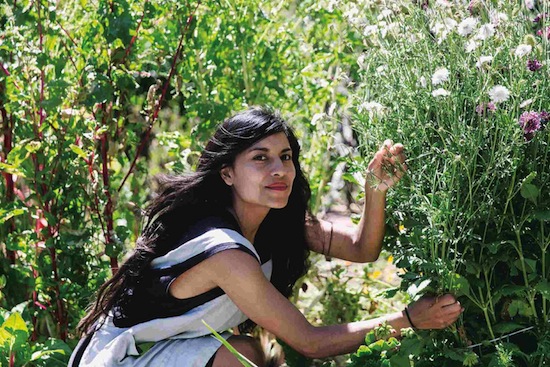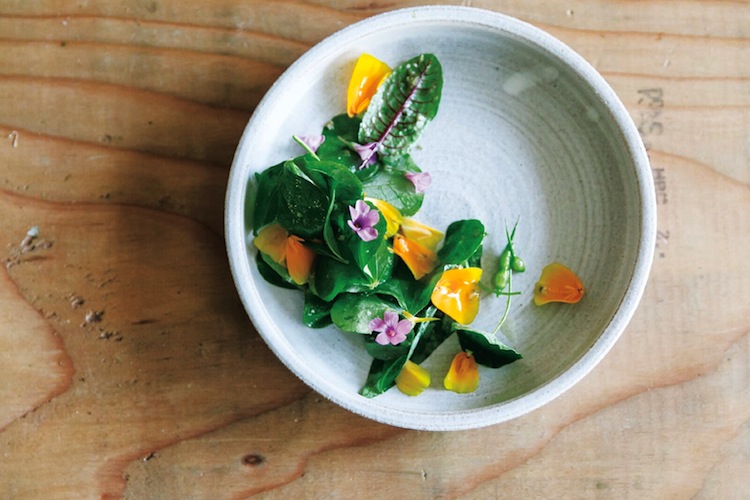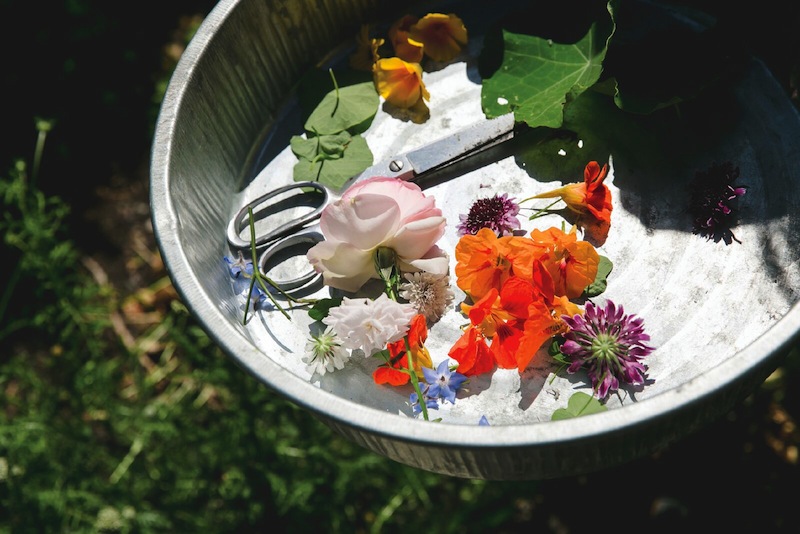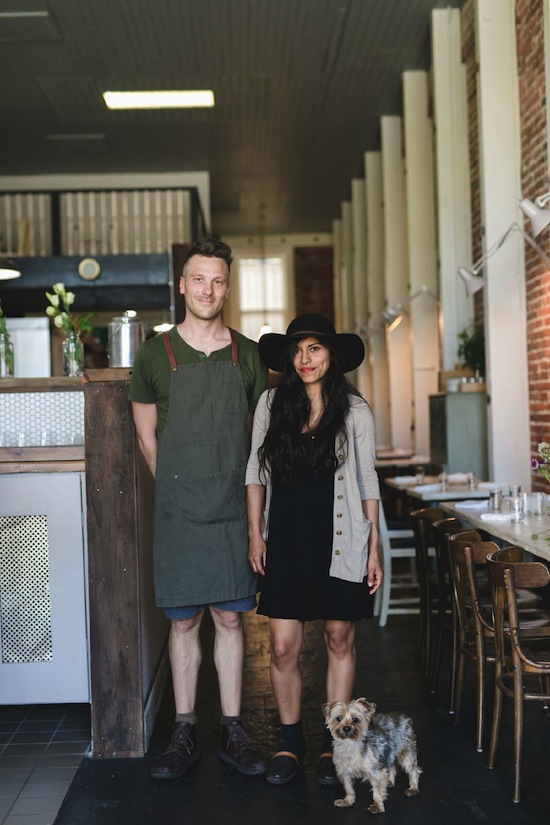How one homegrown cook brought locally sourced, highly crafted Central Asian food to Santa Rosa.
When Dalia Martinez makes dumplings—today’s tasting menu at the restaurant she owns with partner Jason Sakach calls for “uszka,” a polish dumpling that tastes like a tiny cloud filled with savory delights—she often feels a connection with the generations of women across the world who’ve crafted food to nourish families, villages, communities. “I get all babushka about it,” she says with a warm, easy laugh. With her thick, ebony hair pulled back underneath a cap, a blue linen apron, and sensible black shoes, Martinez does look a bit like someone out of time, more 1817 than 2017.
Yet, Martinez is thoroughly modern with a love for cities and culture and the sleek forest aesthetic woven through the design of Flower and Bone, which sits behind large, sun-filled picture windows in a spot between Corrick’s and the tool library in downtown Santa Rosa. The petite 31-year-old wears an air of wisdom and self-assurance that belies her age. It seems to come with the territory for a woman driven by a clear vision to source clean, organic, whole foods directly from local purveyors—no middleman needed.
And, once those vegetables and proteins arrive in her kitchen, to cook that food in a way that’s minimally processed, nourishing, and layered with flavor and texture. It’s an approach she first put into practice at the pop-up turned farmers’ market booth Guerrilla Food, then the Naked Pig—the tiny farm-totable breakfast and lunch joint on Santa Rosa Avenue she and Sakach opened in April 2014—and now at Flower and Bone, where the ephemeral and oft-changing menu finds inspiration in Central Asia.
As Martinez mixes a potato and dill filling, Sakach—who acts as a general manager, of sorts, doing everything from front-ofhouse service to building furniture— stokes the charcoal in a tandoor oven. The oven quickly grows hot, ready to cook pasture-raised chicken morsels and wild fermented rye bread. It was the tandoor, says Martinez, that inspired her vision for the newest restaurant where the “basic founding principles” center on meats and breads cooked in the tandoor, handmade dumplings, housemade preserves and cheeses, local ingredients, and wild and “urban-foraged” foods.
tandoor style
The tandoor lies at the heart of Central Asian cooking. “When I experienced food cooked in that way with a higher technique and ancient technology, I knew I was going to make that a centerpiece of my own kitchen,” says Martinez. She also really wanted to make dumplings. She entered the rabbit hole of Central Asian food, a region that has seen civilization and empires rise and fall for aeons, while having a huge influence on Western food culture.
“The thing that’s so fun about it, for me as a chef, is that it’s a such a big region with major historical influences from different empires, making the food diverse,” says Martinez, who has traveled extensively through the former Yugoslavia, Turkey, Georgia, and other former Soviet-occupied countries. The way the food is presented, the “theater” of it, with multiple courses and “mezes,” which are curated collections of small bites, also held appeal. The structure gave Martinez anopportunity to design a multiple course meal called “The Full Story,” which she scaffolds and structures to optimize digestion and palate. Because of her strict adherence to local and seasonal foods, the story is also fleeting and ephemeral. In other words, there won’t be a tomato chapter to the story in winter, unless they are preserved.
“It’s of the moment and it’s going to change all of the time,” she says. “It’s my very personal creation, and depending on the season, it has a different tone and feeling. It’s an edible story, not told with words.” Not in the mood for an entire book? You can also just walk in and order a tandoor chicken plate or a fresh salad. The experience is up to you.
finding livelihood
Martinez’s own life story started not far from where she stands making dumplings on Fifth Street. She grew up in a house just a few blocks away in the Junior College neighborhood. She went to Fremont Elementary School and graduated from Santa Rosa High School’s ArtQuest, the magnet program in visual and performing arts for kids with a creative bent.
“I grew up in a food-centric family,” says Martinez. “My mother is an amazing cook and she made an effort to cook different meals for us every single night. We had these spreads from all over the world.” The Joy of Cooking was a favorite along with recipes gathered during her mother’s travels to the Middle East and Europe. The family spent weeks each summer on food-centered sojourns to Southeast Asia, Mexico, and Europe.
“If we were warned not to eat in the market, that’s where we’d head,” recalls Martinez. “The first thing we’d see is some woman on the ground making pancakes and my mom would say, ‘We’ll take those!’”
Martinez started cooking for herself while still in high school, and she loved it. But it wasn’t until she was at San Francisco State as a Cinema Studies major whileworking full-time as a visual stylist at Banana Republic’s flagship store in San Francisco, that she started thinking about food as livelihood. And then she read Earth Democracy by noted Indian anti-GMO activist and writer Vandana Shiva. Shiva advocates for the importance of the cottage food industry, which allows people (usually women) of small economic means to cook and sell to their community nourishing, homegrown meals without an infusion of capital. “A safe, affordable, diverse, and sustainable food system requires a transition from globalization to localization,” writes Shiva. Around the same time, Martinez discovered the radical critiques of American foreign policy by linguist Noam Chomsky. Martinez grappled with big life concepts: jobs versus livelihood, the importance of living within your means, the concept of happiness versus monetary wealth, and the role that food production—not just farming— played in the developing of a sustainable local economy and food sovereignty.
“It changed my life,” says Martinez. She quit the corporate job and went to work at an independent coffee shop in San Francisco. With school finished and a bit of breathing space, Martinez hatched the plan for Guerrilla Food, a series of “illegitimate” food events. It was 2011 and a pop-up restaurant wave had engulfed the city though Martinez didn’t know it at the time. She just wanted to make a difference through food. Held at the coffee shop where Martinez worked, the dinners featured a live DJ, film screenings, art shows, and menus composed of whole organic food sourced from her favorite farmers’ market. This was the “Heart of the City” market above San Francisco’s Civic Center BART stop. After eating pesticide free food for about a year, she says her migraine and asthma symptoms disappeared. Martinez began to “avoid pesticides and herbicides like the plague.” She carried this newfound commitment into the Guerilla Food menu. Sakach, who was still pursuing a career as a musician and audio engineer was on board. They sold out every time.
After tossing around the idea of opening a brick and mortar in San Francisco, the couple decided against it. Martinez missed a quieter lifestyle and the access to the ocean and hiking. When her parents bought a second home in Santa Rosa, Sakach and Martinez decided to move home. After going through a rigorous application process, they launched a Guerrilla Food booth at two Santa Rosa farmers’ markets. That went on for three seasons and until they opened the Naked Pig in 2014, on the site of a former Greyhound station on Santa Rosa Avenue. Despite dire predictions, the restaurant has been successful. On weekends, the parking lot fills with customers clamoring for waffles (with local honey not maple syrup) and crispy, creamy Ortiz Farms potatoes. It was all done with lots of sweat equity, $20,000 in savings, and $10,000 from family members.
They stuck with the strict local focus, even if that meant criticism from some quarters. Like the time they ran out of potatoes and left them off the menu until they could find the exact right ones from a local farm.
“We opened a brunch restaurant and people want a side of potatoes,” says Martinez. “And when we told people they couldn’t have potatoes, they called us pretentious. We just want to do the right thing. I didn’t even know how to go out and buy potatoes at Cash & Carry. I just said, well this is it—you don’t get sides here. But when Ortiz Farms had grown enough the next year, and could store them for us, we were able to put side potatoes on the menu and that was really monumental and exciting.”
now, forager
On a late spring afternoon, I join Martinez at her home to see for myself how her garden makes it onto the menu. She andSakach, who met while still in high school, have settled down just a block away from the house where Martinez grew up, and where her parents still live. The front yard of the modest, art filled bungalow in the Junior College district would be best described as “wild cottage.” Martinez greets me at the door holding a small container filled with freshly harvested borage and calendula flowers. She’ll use them to embellish greens, house made paneer, and desserts at that evening’s dinner service. What was once shabby lawn is now an edible landscape blooming with yarrow, sage, weeds, and purple scabiosa sown from seed. There’s Swiss chard, which will make it onto the menu as a bolted chard salad dotted with rose petals. At the side of the house is a heritage quince tree. Martinez uses the fruit and flowers, rich in natural pectin, to make a jam. In the backyard, a patch of wild radish has sprouted from seed foraged at the Sonoma Coast, most likely somewhere around Jenner. The seeds can be pickled and the greens give a spicy twist to salads. Fig leaves from another backyard tree will be used for a subtle, coconut-resembling syrup for cocktails.
Martinez taught herself how to pickle and preserve after putting a hamburger on the Guerrilla Food menu. If she wanted to put ketchup and pickles on the hamburger and stick to sourcing seasonally, then she had to learn how to make them herself. And she did. Flower and Bone’s larder teems with glass jars of tiny white beans, dried mushrooms, seaweed foraged from the Bodega coast, and dried flowers and seeds from the home garden. A bounty of preserves lines shelves in the restaurant’s airy, high-ceilinged dining room. More are tucked away in the kitchen within easy arm’s reach at any given time. Buckets of local Meyer lemons, persimmons, and prickly pear “urban-foraged” from an abandoned the cactus plant nearby ferment in buckets staged along the narrow hallway between the commercial refrigerator and the dishwashing station. They’ll end up as a hooch for house cocktails, or salad dressings, or later, as vinegar for seasoning and acid.
Vegetables are sourced directly from Sonoma County purveyors— mainly Laguna Farms, Ortiz Farms, Wise Acre Farms, and Leisen’s Bridgeway Farms. She’s in contact with the farmers almost every day, finding out what’s growing, what tastes best, what’s thriving. Martinez welcomes the limitation even if they add up to longer days and nights in the kitchen.
“I would never it do it any other way,” she says. “I would never go off of a truck—where the chef is given the maximum choices possible—because the quality is not going to be as spot on. The limitations, when you can’t have a pea from the Central Valley when you want it, are what make creativity happen.”
Sakach says the direct accountability with the producers allows for a sense of what’s going on at each farm at any given time. They are always on guard, never taking anything for granted—an approach that has seen them accused of being too focused and too obsessive. A little too Portlandia. Why can’t they just loosen up a little?
“Look, we stepped up on this platform and we have a responsibility to stand by our principles,” he says. “And that’s what we’re doing. We can’t just be on the whim of a food truck that says, it’s local, it’s organic, but, when it comes down to it, we don’t have any idea where it’s coming from.” They also apply the principles to the restaurant’s pay structure: the dishwasher gets paid the same amount as the servers in an attempt to avoid hierarchy.
Locals have taken notice. Jonah Raskin, a member of Slow Food Russian River and author of Field Days: A Year of Farming, Eating, and Drinking Wine in California, lauds Martinez and Saskach as a “local treasure” for their philosophy, integrity, hard work, and attention to detail.
“I’m in love with what they have done, and are still doing, with food,” he said. “When friends visit from far away, I take them to the Pig, and Flower and Bone, to show off Sonoma innovations.”
Still, the venture down heretofore unexplored alleyways in food brings challenges. Especially in a town like Santa Rosa where people haven’t quite seen anything like it. This isn’t Copenhagen where infamous forager and chef Rene Redzepi turned hyper local “trash” foods into the world’s best restaurant—or even San Francisco, where former Bar Tartine (now Duna) chefs Cortney Burns and Nick Balla found success with a cooking approach steeped in everyday staple foods, cooked, preserved and fermented to perfection, and sourced almost entirely from local farmers and ranchers. Can a business like Flower and Bone, with it’s small plates, preserve and foraged-centric ingredients, and resistance to pizzazz, succeed in a city still wrestling with the transition from farm town to urban center? “If anyone can succeed at such an enterprise, it’s them,” Raskin said. “But it’s definitely an uphill battle to challenge so many aspects of food and dining.”
Martinez doesn’t worry about these things. She approaches it from the lens of a craftsperson—if she and Sakach put in the hard work and stick to what they believe to be right and true, the value will shine through. “We have our niche, the people who don’t expect the food to be something it’s not,” she says. “It’s all about finding your niche and being satisfied with it.”
Which isn’t so bad, when your work, passion, and livelihood all blend into one.





